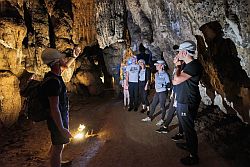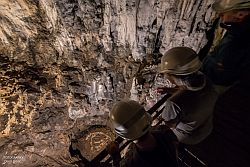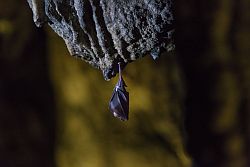Baračeve špilje
Baračeve Pecíne - Barac Caves
Useful Information

| Location: |
Nova Kršlja 47A, 47245 Rakovica.
Near Rakovica town. 120 km south of Zagreb, 20 km north of Plitvice Lakes. From Zagreb follow D1 south, turn left in Rakovice center, 8 km signposted. From Plitvice Lakes follow D1 north, turn right in Grabovac on D217 towards Irinovac, after 3 km turn left to Lipovača, 7 km signposted. Parking lot at the road, 500 m walk to the cave entrance. There is also a small parking lot closer to the cave. (44.984428, 15.723281) |
| Open: |
MAR Fri, Sat, Sun 10-17. APR to MAY daily 10-18. JUN to AUG daily 9-19. SEP daily 10-18. OCT daily 10-17. [2020] |
| Fee: |
MAR to MAY and OCT:
Adults HRK 50, Children (7-18) HRK 30, Students HRK 50, Seniors HRK 50, Scouts HRK 50. JUN to SEP: Adults HRK 75, Children (7-18) HRK 45, Students HRK 50, Seniors HRK 50, Scouts HRK 50. [2020] |
| Classification: |
 Karst Cave Karst Cave
|
| Light: |
 Incandescent Incandescent
|
| Dimension: |
T=9 °C, H=98%. Gornja Baračeva špilja (Upper Barać cave): L=493 m, A=331 m asl. Donja Baračeva špilja (Lower Barać cave): L=519 m, A=309 m als. Nova Baračeva špilja (New Barać Cave): L=94 m, A=305 m asl. |
| Guided tours: | L=200 m, D=60 min. V=4,800/a [2004] |
| Photography: | allowed without flash, no video |
| Accessibility: | no |
| Bibliography: |
Prof. Mijo Kišpatić (1885):
Kosti iz Baraćeve spilje kod Kršlja,
Viestnik Hrvatskoga arkeologičkoga družtva (Bulletin of the Croatian Archaeological Society)
Prof. Mijo Kišpatić (1885): Slike iz Geologije (Pictures in Geology). Zagreb Dragutin Hirtz (1900): Lika i Plitvička jezera (Lika and Plitvice Lakes) Dragutin Hirtz (1905): Prirodni zemljopis Hrvatske (Natural Geography of Croatia). Prof. Josip Poljak (1914): Pećine hrvatskog krša II (Caves of the Croatian Karst II), drawings and photographs of Upper Barać Cave and Lower Barać Cave were published for the first time. Neven Bočić, Aleksandar Lukić, Vuk Tvrtko Opačić (2006): Management models and development of show caves as tourist destinations Croatia, Acta Carsologica. 35. 13-21. 10.3986/ac.v35i2-3.224. online |
| Address: |
Javna ustanova Baraćeve špilje , Nova Kršlja 47 a, 47245 Rakovica.
E-mail: Office: Tel: +385-47-782-113 (Mon-Fri 7-15). Cave: +385-47-782-007 (daily 10-18). E-mail: |
| As far as we know this information was accurate when it was published (see years in brackets), but may have changed since then. Please check rates and details directly with the companies in question if you need more recent info. |
|
History

| 1699 | first written mention by Marsiglia: Povijesti kartografije na području Krajine (History of Cartography in the region of Krajina). |
| 1874 | first description in I. T. Bunek: Die Wassernoth im Karste (The lack of water in the Karst). |
| 1877 | first excavations. |
| 1885 | PhD M. Kišpatić describes finding of a cave bear in the Bulletin of the Croatian Archaeological Society. |
| 20-FEB-1892 | opened to the public for the first time, but only for a year. |
| 1912 | bronze bracelet from the 8th or 7th century BC donated to the Archaeological Department of the National Museum. |
| 1914 | first photographs and drawings of the cave published in PhD Josip Poljak: Caves of the Croatian Karst II. |
| 1968 | explored by the Speleological section Velebit. |
| 1983 | renewed interest in the cave of the area and increased research by several caving groups. |
| 31-AUG-1999 | Committee for the Revitalisation of Barać Caves established. |
| 2003 | protected as an archaeological zone. |
| JUL-2004 | caves reopened to visitors after 112 years. |
| 2013 | archaeological and paleontological research as part of the international Croatian-American campaign. |
| 2015 | archaeological and paleontological research as part of the international Croatian-American campaign. |
| 29-MAR-2016 | wider area of Barać Caves protected as a Significant Landscape. |
| 2017 | archaeological and paleontological research as part of the international Croatian-American campaign. |
Description


For Baračeve špilje (Barac Caves) the plural is really appropriate, there are actually four caves in this hill. The show cave is Gornja Baračeva špilja (Upper Barać cave). It was known for centuries and is described since the 19th century. A first attempt to open a show cave in 1892 failed after only a year. Then it was unfortunately not gated for a long time until finally in the 1990s several locals took the initiative and forced the reopening as a show cave. A non profit organisation was founded, money from funding sources organized, and the cave developed with new trails and electric light. Reopened in 2004 the number of visitors was quite small at the beginning, but it is growing. The site is only 20 km from the world-famous Plitvice Lakes and well worth the detour.
Archaeological and palaeontological excavations revealed the bones of cave bear, cave lion, rhino and others. Human remains were also discovered. Today the cave is inhabited by two bat species, the Great Horseshoe Bat (Rhinolophus ferrumequinum) and the Small Horseshoe Bat (Rhinolophus hipposideros). Rather funny is the fact that visitors are equipped with helmets.
Izvora Baraćevac (Baraćevac Spring Cave) is water filled and only accessible for cave divers. The resurgence is right beneath the entrance to the show cave, the cave river flows through the nice park with its huts and benches. After a few meters it flows into the river Suvaja. The river Suvaja, which runs close to the cave, is a true karst river. It disappears in a swallow hole only a few hundred meters downstream, just to reappear again in a karst spring another 200 m further. It is part of the instructive karst trail with explanatory signs around the cave. Donja Baračeva špilja (Lower Barać Cave) is notable for the endemic insect Mahaerites pavleki. The brown cave bug is only a few millimeters big. Nova Baračeva špilja (New Barać Cave) was the "youngest" discovery, in the 19th century, but the name stuck. Since the mid 20th century speleologists have discovered around 100 caves in the vicinity, which are all "newer". Its possible to visit the entrance of the cave, there is even a trail and a sign. Due to a squeeze beneath the entrance the rest of the cave is only visited by speleologists.
 Search DuckDuckGo for "Baraceve spilje"
Search DuckDuckGo for "Baraceve spilje" Google Earth Placemark
Google Earth Placemark OpenStreetMap
OpenStreetMap Caves of Barać - Wikipedia
Caves of Barać - Wikipedia Baračeve špilje, official website (visited: 03-JUL-2020)
Baračeve špilje, official website (visited: 03-JUL-2020) Index
Index Topics
Topics Hierarchical
Hierarchical Countries
Countries Maps
Maps